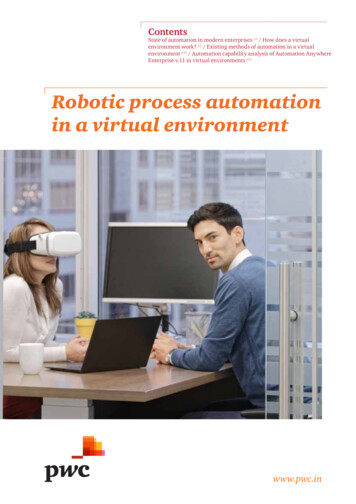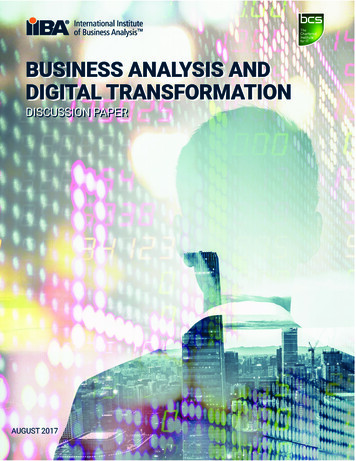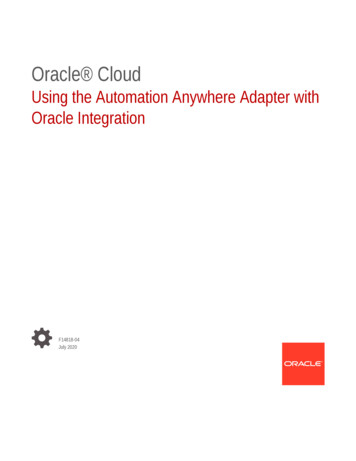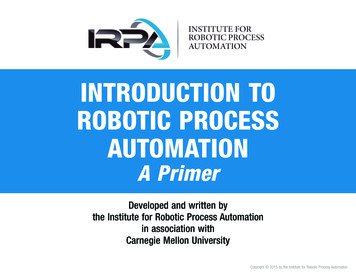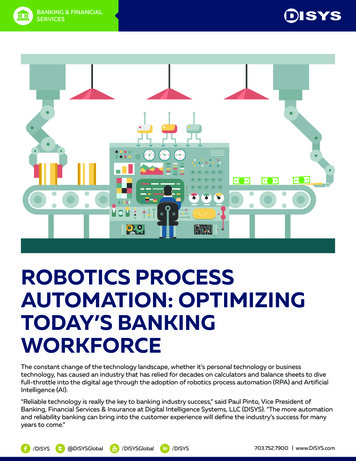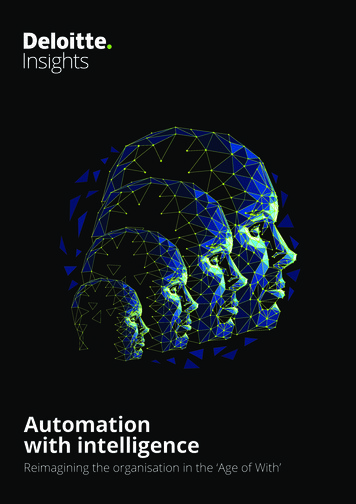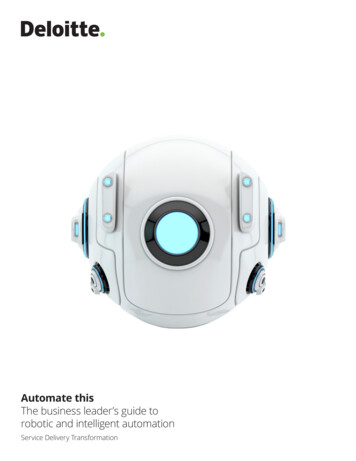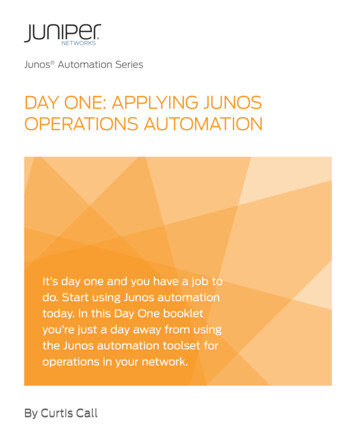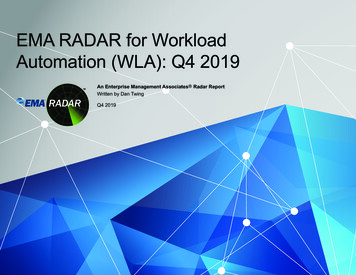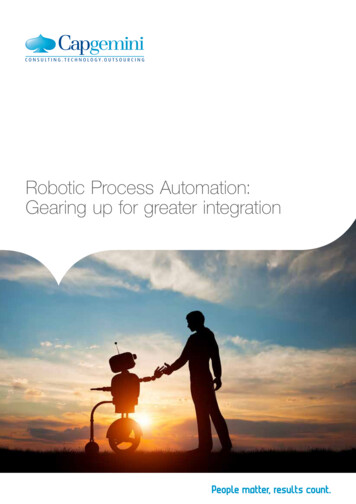
Transcription
Robotic Process Automation:Gearing up for greater integration
Table of ContentsForeword.3Editor’s Note .4Overview.5Benefits.6Key Challenges.7Assessing the Market.8Workplace Transitions.10Employee Engagement Strategy .12Measuring the Feasibility for Successful Adoption.13The New Digital Blend.14Conclusion.162
Robotic Process Automation and Change ManagementForewordThe report that follows was compiledby Storyful on behalf of Capgemini. Bytapping into online discussions, sharedreading material and media consumedby those participating in technologicalinnovation in the area, it offers a uniqueviewpoint of the pulse and passions ofthe region. As such, however, it shouldnot be considered the official viewpointof Capgemini, its employees, clients oraffiliates.3
Robotic Process Automation and Change ManagementEditor’s NoteThe current wave of computer automation in business isdriving a fundamental change in the way companies andemployees interact with their customers and each other.Computing power and data access have unleashed thepossibility to now consider the reality of a robotic workforceas a complement to our traditional organizational structures.From chat bots in our homes, to autonomous cars, andresponsive and interactive mobile apps, we are increasinginteracting with machines as much as we interact witheach other. This new “machine partner” can delight andempower us, but for some, these changes can causeconcern to both the security of their current roles and theirfuture required skills and responsibilities.Today, organizations must face the reality of the virtualworkforce head-on to ensure they remain competitive, butsimultaneously must focus on their employees’ adoptionreadiness to embrace this new way of working, or anypotential and future gains may be fraught with challenges.Alexis ZamkowApplied Innovation Discover Center Lead - TorontoCapgemini4
Robotic Process Automation and Change ManagementOverviewWhat is RPA?Robotic Process Automation, or RPA, describes the application of technology that “allows employees in a company to configurecomputer software or a ‘robot’ to capture and interpret existing applications for processing a transaction, manipulating data,triggering responses, and communicating with other digital systems,” according to the Institute for Robotic Process Automationand Artificial Intelligence (IRPAAI).RPA is typically applied to use cases involving low complexity, high volume, and routine work. An article from Harvard BusinessReview titled, “The 3 Ways Work Can Be Automated” calls these “swivel chair” tasks, where data “needs to be transferred fromone software system to another.”From retail to banking, from IT to HR, and job functions that may span the organization, RPA offers an opportunity for firms to takecertain tasks—payroll fulfillment, onboarding, benefits administration, invoice processing, file management, returns processing, callcenter processes, and data migration—and eliminate activities that are today performed by human workers.RPA advancement has revolutionized IT, HR, and manufacturing industries. So advanced is our acceptance of automation in ourdaily lives—particularly with apps such as Alexa and SIRI offering personal assistance through our smartphones—that the nextwave of RPA adoption is set to infiltrate some of our most skilled workforces, completing data, image recognition and diagnosesreports while ultimately changing the face of healthcare and legal practice. This paper focuses specifically on this next wave ofRPA adoption.5
Robotic Process Automation and Change ManagementBenefitsWhy RPA?Performing tasks swiftly and accurately forms the backbone of RPA business benefits. It also frees up employees to take onhigher-value work and increases productivity across the board.Outside of these advantages, RPA’s appeal lies in its simplicity to implement. As Gartner analyst Frances Karamouzis stated in aninterview with ZDNet, it “just sits on top of the legacy system” without the need for special integrations. “They’re also easy to useand have a relatively low cost. For all those reasons, [RPA] has by far the highest adoption of automation tools that we’ve seen.”These benefits, however, have also sparked fear among employees that the robots may indeed have come to take theirjobs—though in many cases, the purpose of RPA is to re-focus workers on the kind of activities that cannot yet be automated.According to CapGemini’s webinar report Exploring the Wave of Robotic Automation in Canada, the chief benefits for employeesare: The ability to focus on “value adding” initiatives in their daily tasks Outsourcing monotonous, mundane, and repetitive tasks Streamlining workflow processes while reducing human error6
Robotic Process Automation and Change ManagementKey ChallengesWhat’s holding back the enterprise?According to IRPAAI, the key challenges of RPA include: Defining business cases with supporting Returns On Investment (ROI)Preventing scope creep and added complexityAutomating inherently poor process elementsManaging exceptions when they occurStrategy Symphony founder Ian Barkin compared making a case for RPA to when enterprises choose to go green. If they come atan “increased cost of doing business, the initiatives often die on the vine.” RPA is “no different,” he continued.“Enterprises are eager to employ automation of all types, but there must be a compelling and crystal clear business case.For many, that still comes in the form of cost reduction. However, the story is so much more rich and nuanced than that,” heconcluded, warning that focusing on the cost savings goal could blind organizations to the wider strategic benefits that RPA couldprovide.Forrester1 adds a few more challenges to the list based on the reality that RPA, while swiftly growing in adoption, is still a relativelynew technology. As a result, many organizations are facing the following three issues: Governance basics are being defined as we automate Process knowledge gaps create new governance issues Central control of robots is an evolving capability1Le Clair, Forrester - Report PDF attached7
Robotic Process Automation and Change ManagementAssessing the marketAdoption and growth forecastsDue to its strong business case and high levels of efficiency, the amount of new RPA software adopters is now doubling every sixmonths, according to SSON (Shared Services & Outsourcing Network). A 2016 study from Horses for Sources also indicated thata third of global enterprises are already very active with RPA within both their IT and finance and accounting processes.The banking, finance, and insurance industries are leading the charge, according to Market Research Future’s study, followedclosely by adoption in manufacturing, IT, and retail. The report also suggests RPA software will overtake supply chain, accounting,CRM, and HRM workflows, as the benefits of cost savings and higher efficiency allow human staff to focus on deeper analysisand strategy. According to Horses for Sources, the goal of RPA adoption is to allow businesses to use their staff to create newopportunities for growth and profit, rather than simply reacting to their industry environment.A CIO report also questions the legal implications of adopting RPA in financial and legal industries, questioning the training andsecurity of the machines and the data they examine.Among key concerns listed, the report suggests that the most problematic areas may occur in data protection and ownershiponce a contract is complete. CIO notes that a distinct set of guidelines will be required for the termination of a contract. Thisincludes questions: who is entitled to “retain the robot/rules engine? Does the customer have the right to obtain the source code/rules and prevent the service provider from continuing to use it?”To address issues of data collection and privacy, the service provider and customers now need to ensure they hold theappropriate consent in place from individuals whose personal information is processed by robots. CIO suggests that an additionalcontract may be required, one which “imposes appropriate contractual obligations on the service provider with respect to thestorage, access and processing of that information.”In supporting the need to review their systems of auditing and consent, one vendor writing for the Harvard Business Reviewstates, “They should implement procedures to audit the real effects of any automated systems, and there should always berecourses and overrides as part of the processes. AI systems that use data about people should involve informed consent.”A 2017 Harvard Business Review article, “How Companies are Already Using AI,” also notes IT’s leadership in the space.According to a survey of 835 firms, 34 to 44 percent of global companies are using technology to “resolve employees’ techsupport problems, automate the work of putting new systems or enhancements into production, and make sure employees usetechnology from approved vendors.”8
Robotic Process Automation and Change ManagementThe market for RPA will grow at a CAGR of 47.1 percent between 2016 and 2024, according to Transparency Market Research. Ifaccurate, this will indicate a market value of more than 16.8 billion by 2024.Today, RPA has been “predominantly” adopted in North America, according to the report, with “significant” growth expected.Transparency also noted that both Europe and Asia Pacific, especially technologically advanced countries such as China andJapan, will adopt RPA between now and 2024.The retail bank industry is witnessing major industry transformations thanks to the rise of RPA tools. A report from Fortune.comrevealed that Bank of America intends to move to fully automated branches as part of their 2017 expansion plans. The groupopened three completely automated branches in January 2017, where customers can use ATMs and have video conferences withemployees at other branches. While the bank forecasts opening 50-60 new branches in 2017, signaling new roles for customerservice agents, they have also indicated the closure of branches in quieter markets as part of the rollout.According to a report by Globe Newswire, Eastern Europe is expected to have the most substantial growth in the near futuredespite the fact that North America and Europe were the first major adopters of RPA tools. This is based on the level of researchand development in Europe and India, and an examination of revenues in various geographical regions.From current patterns emerging from North America and Europe, it is expected that banking, finance and manufacturing willcontinue to lead industry in the adoption of RPA tools.Is 2017 the year RPA breaks into the mainstream?In an interview with IRPAAI, Guy Kirkwood, founder of UIPath (a leading RPA vendor) claims that the landscape has shifteddramatically in the last two years: the need to gain competitive advantage and the desire to create new consumer servicesfeeds the “spectacular pace of client activity driven by an increased urgency for rapid time-to-market.”The shift, according to Kirkwood, is the result of two major considerations for greater RPA adoption:Credibility: Twenty-four months ago, RPA had serious credibility issues—not because it was a new and unfamiliartechnology (though that certainly had an impact), but because what the technology claimed it could do was unprecedented.When clients heard or read that robots were non-disruptive, blazing fast, error-free, inexpensive and quick to implement, andcould reduce costs by double digits, it was hard for many of them to take RPA seriously. Over the past year, however, a risingtide of irrefutable use cases have emerged to put these credibility issues to rest.Capability: Two years ago, robots were primarily single-user automation tools residing on the employee’s computer.Now, leading RPA providers offer enterprise products capable of deploying autonomous robots in large-scale automationsolutions.9
Robotic Process Automation and Change ManagementWorkplace TransitionsThe role of change managementFear of the unknown, and the threat of RPA technology replacing human workers, largely dominated the conversation on theemerging tech trend. Yet, as highlighted by an article in Forbes entitled, “This is How Mark Cuban Thinks Humans Could TrumpThe Rise of Automation,” the introduction of an RPA workforce will see an increasing demand in sourcing workers with “soft skills”and engineering backgrounds.Cuban echoes Peter Drucker, an expert on modern management and change management, saying that humans will still be anecessary element in deciphering and analyzing the true value of computer-compiled data. In fact, Cuban predicts there will be “agreater demand in 10 years for liberal arts majors than there were for programming majors and maybe even engineering” as RPAtechnology takes hold.Supporting this theory is founder and chairman of the IRPA, Frank J Casale. Upon predicting the challenges ahead of the secondwave of RPA adopters in 2017, Casale warns that the demand for technology advancement in the workplace will far outweighcurrent RPA ability, as well as the talent to manage and operate them.For this reason, change management is vital in securing a harmonious workforce while software is developed. At the 2016Automation Innovation Conference, attendees marked the acceptance of human employees as the greatest indicator of successor failure at implementing RPA in a company. According to Casale, developing a “people plan” strategy to introduce RPAtechnology was a key focus in every workshop, panel session, and individual meeting held during the event.An organization’s IT department will be instrumental in leading change management to create a digitized workforce. Although RPAmay be a business-made decision—as benefits and low-cost profits have been clearly outlined—it is the algorithms and the abilityto analyze and interpret data that will determine whether a role can be automated. This testing of software and the establishmentof RPA excellence centers, shows a growing need to first harness the technology, and then implement it.There are many examples where RPA has increased the demand for a new and varied workforce. Use cases prove that employersnot only save money with the introduction of RPA tools, but also increase productivity, employee safety, and in some instances,create new opportunities for skilled workers and apprentices in their respective industries.Addressing the newest additions to the healthcare industry, WIRED.com reports how hospitals will now be able to advancetheir IT infrastructure “with a 1,000 graphics processor” to “ boost their capacity up to 260 million images per day.” The resultcould mean a bank of data across MRI, CT scans, and radiology that could automate traditional roles. Eric Topol, director of theScripps Translational Science Institute and a leader in the NIH’s Precision Health Initiative, states that the roles of MDs in imageinterpretation, “namely pathologists, radiologists, and dermatologists” are the most at immediate risk, but warns that RPA will bewidespread across medicine as RPA software continues its sophistication.10
Robotic Process Automation and Change ManagementIn fact, the article quotes a study from Nature science journal where a team of scientists and physicians at Stanford Universityrecently joined forces to detect the strength and accuracy of a deep learning algorithm on 130,000 images and 2,000 skin images.The experiment found that the RPA software performed as well as 21 board-certified dermatologists, quoting that RPA “achievesperformance on par with all tested experts across both tasks, demonstrating an artificial intelligence capable of classifying skincancer with a level of competence comparable to dermatologists.”In February 2017, international legal group Seyfarth Shaw announced their adoption of RPA software across their legal services,with plans to establish RPA centers to formalize the software’s capabilities, machine learning, and artificial intelligence. Speakingabout the new development, chair Stephen Poor said that the move will “free our lawyers from some of the more mundane legaltasks so they can focus on helping our clients solve their most complex business issues.”As with all industries, when RPA software is programatically introduced, there is an element of transition within teams. Whilethis level of RPA software may displace some healthcare professionals, one could argue that it adds value to the business byunlocking more time for doctors to develop a relationship with patients and clients.Speaking to The Economist, Jerry Kaplan, author of “Humans Need Not Apply” says automation is now “blind to the color of yourcollar.” The pattern of automation relays the need for human workforces to adopt RPA in their industries to alleviate the risk ofjob loss.A key takeaway from the establishment of RPA in an organization is that while the introduction of automation will inevitably makesome roles redundant, the economic value of tasks that can only be completed by humans will drive a new demand for workers inthese key industries.11
Robotic Process Automation and Change ManagementEmployee engagement strategyWhat HR and employers should reassess when itcomes to successfully adopting an RPA workforceWhile automation continues to change the face of the workforce, there is an opportunity for employers to create new nichemarkets or incentive schemes that not only benefit their business, but also upskill employees who previously held automated roles.Professor Darlene Damm, Principal Faculty of Global Grand Challenges at Singularity University, believes the onus lies onemployers to lead the field of social innovation by expanding their strategies and offering incentives for workers to adopttechnology advances in their industry.A December 2016 report from Conduent entitled, “Improving Employee Engagement,” supports the theory that theconsumerization of the workforce results in increasing profits. HR departments that work within their organizations to findflexible approaches to accommodating difficult transitions for staff have seen greater employee engagement and loyalty tothe company—a common issue for industries adopting RPA technology. By getting a handle on resistance to change, HRdepartments now play a vital part in implementing the increasing role of RPA in the work environment.As management expert Gary Hamel says, “Engagement may have been optional in the past, but it’s pretty much the whole gametoday.” Speaking from experience of a transitioning workforce, SVP of Apple Retail, Angela Ahrendts adds, “Everyone talks aboutbuilding a relationship with your customer. I think you need to build a good one with your employees first.”Supporting this theory, RoboticsTomorrow.com addresses the need to manage three types of change while introducing RPAtechnology: individual change, organizational change, and transformational change.On an individual basis, report author and RPA Transformation Lead Rita Brunk suggests that the resilience to automationoriginates from a mix of fear and misinformation. By introducing an appointed management specialist, the key for engaging yourworkforce will be to keep employees informed throughout the process. “These situations require crystal clear communication,professional training, and guidance,” she explains. The report also notes that engaging individual workers at the beginning of thechange management process will place the business “in the best position to identify automation opportunities” as workers sharethe repetitive and systematic tasks that could be automated.For those working with teams and departments, Brunk suggests an organizational change management plan, where teams canactively educate and support one another throughout the journey. When both individual and organizational management strategiesare adopted, a company can move into the final stages of the shift with transformational management. By acknowledging theimpact on overall strategic planning, communication, and leadership of the business, Brunk argues that it is possible for acompany to “evolve to meet the needs of the modern, automated workplace” without the risk of human staff sabotage.12
Robotic Process Automation and Change ManagementMeasuring the feasibilityfor successful adoptionWhile being undeniably touted as one of the leading trends in workplace technology, the complexity of offering an RPAled solution depends on both the nature of the work to be automated, and an extensive audit of an organization’s ability tosuccessfully adopt it as part of an IT structure.By nature, RPA is a completely rule-based service, where data is captured, structured and a digital format is applied. Whenconsidering the onboarding process of RPA, a company should work with an automation architect who will assess the solution’sneed to assess the robots’ need to reliably read screens, write to fields, click buttons, extract data from grids, and chart tasks.One vendor states, “The only way for an Automation Architect to fully understand a project’s complexity is to spend some timewith the applications.”The vendor adds that this initial assessment can identify potential pitfalls, notably where the process involves some subjectivedecision-making.Addressing the needs of the task and RPA output aides in the design of an automated solution that allows humans to manage thesubjective process elements while robots take care of data entry and validation. While designing a solution around a process isthe best approach, it often requires tweaking the overall process flow.Other factors that need to be considered when selecting processes for RPA development include: application stability frequency of procedure changesWhile they don’t affect automation feasibility, they could still hinder the success and optimization of adopting RPA in a workforce.An extensive audit of the processes to be automated, the application stability, and the frequency of changes will not only preparethe terrain for RPA adoption, but also outline budgets to allow for an adequate ROI; updating robots and programs should befactored into the process when selecting an automated solution.A second vendor adds that only after all facts are considered and accounted for can RPA be considered successfully optimized.“Instead of seeing RPA as the panacea for operational problems and broken processes, organizations need to recognize the limitsof what RPA can and cannot do;” the real value and benefits can be measured against RPA’s real deliverables.13
Robotic Process Automation and Change ManagementThe new digital blendWhat companies should really be consideringbefore taking the RPA plungeWhat companies should really be considering before taking the RPA plungeWhile lean management and Six Sigma both address process flow and waste issues, applying these principles to a company’smanufacturing processes may help structure the adoption of RPA tools and guide a company to automate fruitful production andcustomer care areas.The Process Excellence Network notes how the latest round of digital transformation in companies, driven by advancesin consumer technology, has set the backdrop for a deep shift in business processes. One vendor quotes that while mostcompanies adopt RPA “from a ‘user-centric’ view that simply mimics what users do,” undertaking a full analysis of human defectsand variability of service will allow businesses to adapt to a “process-centric” view, which will benefit business processes in theirentirety and focus a company on the areas worth automating.To streamline a business and adopt RPA, lean management and Six Sigma principles lead the way in determining how tointroduce effective changes to ensure a successful software introduction. While first a company must review its own internalprocesses, a full audit of each task and its automation potential will allow companies to assess the adaptability of theirorganization to embrace RPA.Writing for Harvard Business Review, one vendor describes two key barriers to introduction as being: “The availability of large quantities of high quality data that can be used to train algorithms. In many organizations, the data isn’tin one place or in a useable format, or it contains biases that will lead to bad decisions. To prepare your enterprise for the future,the first step is to assess your existing information systems and data flows to distinguish the areas that are ready for automationfrom those where more investment is needed. “. and prioritization; with so many opportunities, it can be hard to know where to start. To ease this burden, software providersare starting to offer predefined solutions enabled with state-of-the-art machine learning out of the box. Many organizations arealso implementing AI centers of excellence to work closely with business departments.”Best practice in lean management and Six Sigma principles dictate the creation of a Robotics Operating Model (ROM). The ROMwould define the critical roles and interfaces to manage RPA.14
Robotic Process Automation and Change ManagementAn ISG report supporting lean management and Six Sigma principles suggests an audit questioning: What are the right processes to optimize? What are the organizational capacities and capabilities needed to embrace RPA? Is there a strong network among business managers, IT leaders, and functional administrators to promote experimentation bypiloting new RPA initiatives?As RPA tools continue to see unprecedented growth across industries including finance, HR, health, and law, the demand toadopt an automated—and cost-effective—workforce will undoubtedly be met by a surge of vendors entering the market.In fact, ZDNET reports that there will be an “AI overdose” of solutions from vendors. One of ZDNET’s vendors outlined the need tointegrate technology slowly into a company, saying, “Human beings to AI is not the right step. You need digital employees first.”Writing for CIO, product and design manager Tarun Gangwan warns those looking into adopting RPA to fully consider what it willtake to earn staff commitment for an implementation to be a success.Inadequate training or a rushed approach to implementation could negatively impact the customer experience and losethe “efficiency” that was the original reason for investing in the technology. Gangwan characterizes the debate around theadvancement of RPA as a series of questions to consider, including, “can a small fix provide big impact without A.I.?,” whattechnical and human resources need to be strengthened before we can capture customers, and how much time do we have toadopt a new strategy? How will customers understand the new technology? Will we have the staff to teach them?”A new “digital blend” demonstrates the need for a multi-faceted approach to adopting RPA tools. To safely consider a move toan automated workforce, the digital approach requires a committed, engaged workforce, employers who recognize employeesbefore profits, and an assurance that the output of the technology is customer friendly while supporting the required tasks withinthe current business infrastructure.When considering the internal digital blend of a company, one vendor states:“The best course is going to be to step back and think holistically and outline how automation, AI, and your corporate systems willblend together. Otherwise, we’re going to enter the age of AI sprawl pretty quickly.”As managers pursue AI and RPA for their organizations, there are several questions to consider when building out a digitizedworkforce alongside current employees: where will AI and RPA be most effective? How can their processes be properlymanaged? How should one take into account data privacy concerns?15
Robotic Process Automation and Change ManagementConclusionRPA has possible applications in a number of industries; the potential to cut out monotonous tasks across a wide variety of roles,functions, and departments; and a relatively unobtrusive technical implementation with a shallow learning curve for those in theorganization who rely on it.As different organizations roll out RPA, a configuration that works for one may not work for another, from enterprise-wide setupswhere every function is incorporated, to smaller deployments with more limited scope. While automation of back-office processes,particularly in finance and HR, continue to be adopted, the IRPAAI predict that late 2017 will welcome a second wave of adopterswho will signal a “takeover” of RPA.Looking forward, layering cognitive automation into existing RPA structures may carry the potential for even more advanced usecases that get even closer to doing the work that humans alone perform today. But in the coming year, the major potential foraccelerated adoption of RPA remains something to watch.16
Who Is Storyful?Storyful is the world’s first social media news and intelligence agency with over seven years of experience working with publishers andbusinesses around the world. Billion
1 Le Clair, Forrester - Report PDF attached 7 Robotic rocess Automation and Change Management. Assessing the market Adoption and growth forecasts Due to its strong busines
